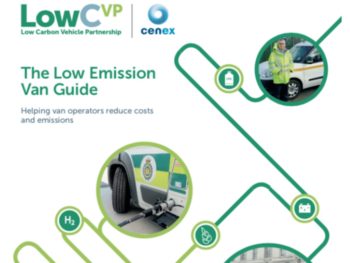The Low Carbon Vehicle Partnership and Cenex have published a new Low Emission Van Guide to help fleets cut fuel cost, emissions and climate impact.

Published to coincide with this week’s CV Show in Birmingham and the DfT’s announcement of revised licensing for drivers of alternatively fuelled vans, the guide comes at a time of growing pressure for fleets to consider low and zero-emission vehicle options; from the climate emergency declared by the UK Parliament to the growing number of Clean Air Zones in cities in operation, including London’s Ultra Low Emission Zone.
But not only can cutting van emissions – which now represent about 33% of all oxides of nitrogen and more than 15% of the CO2 emissions from all road transport – make environmental sense, it can also make business sense as lower carbon vehicles can be cheaper to run.
The Low Emission Van Guide provides an overview of low-emission vans, the alternative fuels and technologies that can be used as well as providing advice on fleet management best practice.
It includes information on:
- The low-emission van market and range of government incentives for adoption available
- The most appropriate technologies for circumstances relating to particular fleets
- The key factors to consider in terms of low emission vans, fuels and related technologies
- Best practice options for cutting costs and emissions from conventional vehicles
- A selection of ‘real-world’ case studies showing what can be achieved
This practical guide looks at operational, financial and environmental considerations and a range of technology options including battery electric vans; plug-in hybrid and extended range electric vehicles; charging infrastructure; liquefied petroleum gas and BioLPG; compressed natural gas and biomethane; high blend biodiesel and hydrogen fuel cell and dual fuel options.
LowCVP’s managing director, Andy Eastlake, said: “Government has committed to all new vans in 2040 being effectively zero emissions, so we need to move now if we’re going to get fast enough down that Road to Zero.
“Technology is advancing rapidly in many areas and it’s vital that fleet managers are up-to-speed with the latest options. This new guide should help them get close to the forefront of developments and plan for the future.”
Cenex’s head of transport, Steve Carroll added: “This clear and informative guide is an essential read for van operators. It sets out the business and environmental case for a range of lower emission and zero emission technology options available to replace the use of conventional diesel vans – as well as an introduction to installing and overcoming infrastructure challenges.”
Print copies of the Low Emission Van Guide are available at the CV Show from stands including, including BVRLA (Stand F403), Commercial Motor (4G35) Autogas Ltd (3E30) and Ford (FE10 & FE20).
A digital download of the report is available here.

